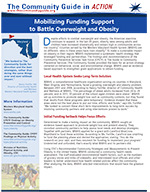Mobilizing Funding Support to Battle Overweight and Obesity
Summary
 The Western Maryland Health System used a health strategy that systematically leveraged funding and partnerships as a way to reduce obesity in their region. They used The Community Guide as a resource to develop a strategy centered on behavioral, social, and environmental change, along with evidence-based approach to strengthen grant applications. (Released 2012)
The Western Maryland Health System used a health strategy that systematically leveraged funding and partnerships as a way to reduce obesity in their region. They used The Community Guide as a resource to develop a strategy centered on behavioral, social, and environmental change, along with evidence-based approach to strengthen grant applications. (Released 2012)Lessons Learned
- Invest the time to gather the evidence. Taking time to assess their community’s needs and identify evidence-based interventions made the difference in obtaining the needed funds. Their persistence and use of an evidence-based approach eventually led to success.
- Apply The Community Guide. Use the Task Force recommendations from The Community Guide to support and enhance other programs and interventions that will benefit your community. Combined with data specific to the target population, the project’s design and reach may be more effective.
- Combine interventions and partners. The combination of behavioral, social, and environmental strategies can impact a population more strongly than a single strategy. Involving partners in different community sectors can improve the reach of each intervention. A varied approach increases the likelihood that the message will take hold within the community.
Story
Local Health System Seeks Long-Term Solution
WMHS, a comprehensive healthcare organization serving six counties in Maryland, West Virginia, and Pennsylvania, faced a growing overweight and obesity problem. Between 2001 and 2008, according to Nancy Forlifer, director of Community Health and Wellness at WMHS, “The percentage of obese adults increased from 24 to 29 percent, and in 2011, 20 percent of the school-aged children were obese.” WMHS set up activities to promote weight loss such as community contests, but they found that results from these programs were temporary.” Evidence showed that these areas were not the best place to put our time, efforts, and funds,” says Ms. Forlifer. “We looked to convert these short-term improvements to long-term success by involving community partners and using interventions proven to work.”
Initial Funding Setback Helps Focus Efforts
Determined to make a lasting impact on the community, WMHS sought an evidence-based approach to promote weight loss and prevent obesity. They recruited community partners to help assess local needs and develop strategies. Together with partners, WMHS applied for a grant with CareFirst BlueCross BlueShield to fund these activities. According to Ms. Forlifer, CareFirst was unwilling to fund the planning phase and denied the application, stating, “You do the research on your own, and then resubmit for funding to implement your program.” Undeterred and unfunded, that’s exactly what WMHS and its partners did.
Using CDC’s Recommended Community Strategies and Measurements to Prevent Obesity in the United States, WMHS conducted a community health needs assessment. The staff evaluated environmental health factors, such as the numbers of grocery stores and miles of sidewalks, and interviewed local officials and other leaders to better understand how health-related policies affect the community. After analyzing the data, WMHS selected interventions that would have the greatest impact.
The Community Guide Influences New Action Plan
WMHS turned to The Community Guide to inform the development of a stronger funding proposal that would identify Task Force recommendations that best addressed their community needs assessment. WMHS chose evidence-based strategies that target obesity and physical activity through behavioral, social, environmental, and policy changes. The Task Force recommendations used included:
- Behavioral interventions to reduce screen time
- Community-wide campaigns to increase physical activity
- Social support interventions in community settings
- Creation of or enhanced access to places for physical activity combined with informational outreach activities
WMHS Puts its Plan into Action
With a clearer picture of the community’s needs and a comprehensive evidence-based plan of action, WMHS’s second funding proposal was successful. In 2011, CareFirst and Maryland Physicians Care awarded WMHS grants totaling $125,000. WMHS used these funds to kick off various parts of their program Make Healthy Choices Easy. Two parts of the program were based on findings and recommendations from The Community Guide:
- A “Turn Off Challenge” aimed at reducing the amount of time people watch television and play video games
- Two “Mall Movers” walking groups to encourage community-wide organized physical activity, social support, and enhanced access to local facilities
WMHS secured more than 12 partnerships with local organizations as diverse as the Allegany County Board of Education, the Country Club Mall, and the YMCA. “As we implement these programs influenced by The Community Guide, we find that more people are interested in being partners with us,” says Ms. Forlifer. “Using the Task Force findings and recommendations in The Community Guide, we have mobilized funder support and are making strides toward combating the problem of obesity in our community.”
1 Centers for Disease Control and Prevention. U.S. Obesity Trends. www.cdc.gov/obesity/data/trends.html. Accessed on March 20, 2012.
2 Centers for Disease Control and Prevention. Behavioral Risk Factor Surveillance System Survey Data. Atlanta, Georgia: U.S. Department of Health and Human Services, Centers for Disease Control and Prevention, 2005-2010. http://apps.nccd.cdc.gov/BRFSS-SMART/SelQuickViewChart.asp. Accessed on March 23, 2012.
More Information
Division of Nutrition, Physical Activity, and Obesity, CDC
Community Preventive Services Task Force findings referred to in this story:
The Community Guide: Task Force Findings on Obesity Prevention and Control
The Community Guide: Task Force Findings on Physical Activity